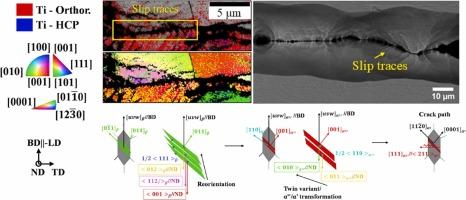Stress-induced martensitic transformation mechanism in the crack behaviour of compressed additively manufactured Ti-5553 alloy: A variant selection approach
IF 11.1
1区 工程技术
Q1 ENGINEERING, MANUFACTURING
引用次数: 0
Abstract
This investigation aims to explore the unresolved crack formation mechanism in compression, based on the influence of the crystallographic nature in the Ti-5553 alloy, which is susceptible to Laser Powder Bed Fusion (PBF-LB) defects as well as stress-induced martensitic transformations (SIMT). The cylindrical samples were obtained and subsequently subjected to a compressive load to investigate the BCC/orthorhombic transformation in the failure behaviour. Here, the variant selection approach based on the Schmid factor (SF) criteria was employed to elucidate the martensitic phase transformations and their role in the crack path. It was demonstrated that the accumulation of plastic strain at discontinuities that result from the processing route initiate the martensitic transformation. Additionally, a stacking fault in the orthorhombic phase will assist the α’’/α’ (Orthorhombic/Hexagonal closed packed - HCP) transformation. The analysis showed that the SIMT mechanism follows the //// and //// orientation relationship and that the failure on the transverse direction follows a direction close to // //TD.

压缩增材制造Ti-5553合金裂纹行为的应力诱导马氏体转变机制:一种变体选择方法
基于Ti-5553合金易发生激光粉末床熔合(PBF-LB)缺陷和应力诱导马氏体相变(SIMT)的晶体性质的影响,本研究旨在探讨在压缩条件下未解决的裂纹形成机制。获得圆柱形试样,并随后施加压缩载荷,以研究破坏行为中的BCC/正交变换。本文采用基于Schmid因子(SF)准则的变量选择方法来阐明马氏体相变及其在裂纹路径中的作用。结果表明,加工路线引起的不连续处的塑性应变积累引发了马氏体相变。另外,正交相中的层错有助于α′/α′(正交/六方闭合堆积- HCP)转变。分析表明,SIMT机制遵循{101}β//{001}α " //{0001}α ‘和<;111>β//<110>α " //<112′0>α ’取向关系,横向破坏遵循接近<;212>β //< 211>α " //TD的方向。
本文章由计算机程序翻译,如有差异,请以英文原文为准。
求助全文
约1分钟内获得全文
求助全文
来源期刊

Additive manufacturing
Materials Science-General Materials Science
CiteScore
19.80
自引率
12.70%
发文量
648
审稿时长
35 days
期刊介绍:
Additive Manufacturing stands as a peer-reviewed journal dedicated to delivering high-quality research papers and reviews in the field of additive manufacturing, serving both academia and industry leaders. The journal's objective is to recognize the innovative essence of additive manufacturing and its diverse applications, providing a comprehensive overview of current developments and future prospects.
The transformative potential of additive manufacturing technologies in product design and manufacturing is poised to disrupt traditional approaches. In response to this paradigm shift, a distinctive and comprehensive publication outlet was essential. Additive Manufacturing fulfills this need, offering a platform for engineers, materials scientists, and practitioners across academia and various industries to document and share innovations in these evolving technologies.
 求助内容:
求助内容: 应助结果提醒方式:
应助结果提醒方式:


